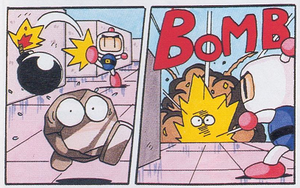Category:Enemy characters
Enemy characters (敵のキャラクター[1] teki no kyarakutā or 敵のキャラ[2] teki no kyara) are a core gameplay element of most Bomberman games. They populate most stages, moving around with different patterns and acting as obstacles for the player, typically causing harm on collision. The player's objective in most Bomberman games is to destroy all enemy characters in a stage in order to activate the exit.[3]
Patterns
Each enemy character is bound to a specific movement pattern, creating more streamlined behaviours. Enemies of different movement patterns work together to produce more complex situations for the player to face. In a typical Bomberman game, there are four different movement patterns. The most common patterns are as follows:
- Feigned Ignorance Pattern (おとぼけパターン otoboke patān) - The simplest pattern. In some games, the enemy changes directions randomly.[4] In other games, the enemy only changes directions when it collides with a wall or a bomb.[5] This is sometimes known as Whim Pattern 1 (きまぐれパターン1 kimagure patān 1)[6] or Whim (気まぐれ).[7]
- Whim Pattern (気まぐれパターン or きまぐれパターン kimagure patān) - This pattern functions identically to the Feigned Ignorance Pattern, but when the enemy lines up horizontally or vertically with a player character, it turns toward the player.[4] Though this pattern is more observant and potentially more dangerous, it also makes the enemy easier to lure into a trap.[5] This is sometimes known as Whim Pattern 2 (きまぐれパターン2 kimagure patān 2).[6]
- Whim Attack Pattern (きまぐれ攻撃パターン kimagure kougeki patān) - This pattern functions identically to the Whim Pattern, but at the moment the enemy turns toward the player, it also issues a special attack.[5]
- Player Search Pattern (プレイヤーサーチパターン pureiyā sāchi patān) - Enemies that utilize this pattern will constantly try to reach the player's position, trying to take the shortest path.[6] This is one of the more dangerous patterns, as it makes the player much more likely to become trapped. Depending on the game, the enemy may avoid walls, or it may not; the latter type is easier to evade as it often traps itself behind barriers. This pattern is sometimes known as Chase Pattern (追いかけパターン oikake patān).[4]
- Bomb Search Pattern (ボムサーチパターン bomu sāchi patān) - This pattern functions like the Feigned Ignorance Pattern until the enemy lines up with a bomb, at which point the enemy will turn and move toward the bomb.[6] Enemies of this type typically have a special interaction with bombs, such as removing them from the field or throwing them to other spaces. Their abilities to manipulate bombs makes them harder to defeat despite being easier to lure.
- Wait Pattern (待ちパターン machi patān) - Enemies of this type tend to linger around their start locations.[4] If the enemy ventures too far from its original position, it will try to head back. This may make them easier to defeat.
- Ambush (まちぶせ machibuse) - This pattern is similar to the Wait Pattern, but when the player approaches, the enemy will issue an attack or begin pursuit.[7]
It should be noted that most enemies are not observed to reverse their direction unless they become trapped in a space where they cannot turn in another direction.
References
- ↑ ボンバーマン 取扱説明書, HFC-BM, Hudson Soft, 1985, p. 6
- ↑ Bomberman II 取扱説明書, HFC-2X, Hudson Soft, 1991, p. 7
- ↑ Bomberman Operation Manual, NES-BM-USA, Hudson Soft USA, 1989, pp. 5-6
- ↑ 4.0 4.1 4.2 4.3 Super Bomberman 3 Hudson Official Guidebook, Shogakukan, 1995, p. 21.
- ↑ 5.0 5.1 5.2 Super Bomberman 4 Hudson Official Guidebook, Shogakukan, 1996, p. 23.
- ↑ 6.0 6.1 6.2 6.3 Super Bomberman 2 Hudson Official Guidebook, Shogakukan, 1994, p. 27.
- ↑ 7.0 7.1 Saturn Bomberman Hudson Official Guidebook, Shogakukan, 1996, p. 17.
Pages in category "Enemy characters"
The following 19 pages are in this category, out of 19 total.
